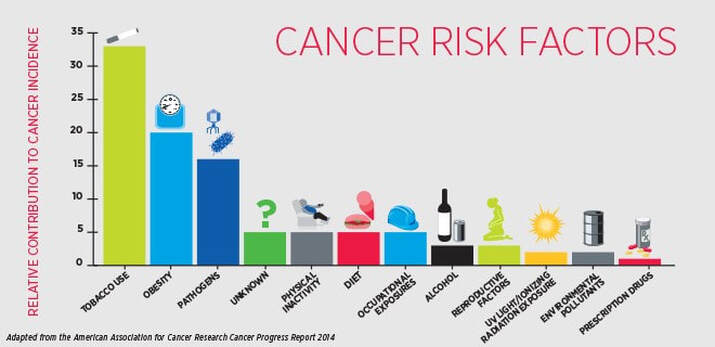|
The dinner table is set, and the aroma of a home cooked meal fills the house. An announcement from the kitchen, “Dinners ready”. I join my wife and daughter in the dining room and we sit down to enjoy a nice meal and discuss the day’s events. The three of us sit down and a statement by the WHO organization echoes in my head “One in two people will get cancer in their lifetime.” According to the World Health Organization (WHO) one out of two people will be diagnosed with cancer in their lifetime… That is an incredibly alarming statistic! Half the population will be directly affected by cancer and the other half will be indirectly affected. That means cancer will impact literally every single person on the planet! Cancer is a leading cause of death worldwide, accounting for an estimated 9.6 million deaths in 2018. The impact of which goes beyond health and mortality. The annual toll on the economy increases every year. In 2010 that cost was upwards of US$ 1.6 trillion!!! A large portion of that goes towards the management of existing cases, but the majority goes towards the development of new treatments and the search for a cure. Cancer prevention is not included in this budget. If you’ve seen cancer up close then you know that this is not a fight worth waiting for. While we hope for a cure tomorrow, how can we incorporate effective preventative measures today? As always, we start with education. To prevent something, you have to first understand where and how it’s going to occur. Here are the leading cases to look at:
According to the American Association for Cancer Research (AACR), research has shown that more than 40 percent of all cancers diagnosed in the United States can be attributed to preventable causes - things like smoking, obesity, sedentary lifestyle, and excessive exposure to the sun and other factors shown below. That immediately begs the question, what about the other 60 percent? Even if a person were to eat healthy, exercise, not smoke, resist drinking alcohol, and avoid getting sunburned, those are still not good odds... What is the cause? According to WHO, historically, the greatest reductions in cancer related deaths have been achieved through the implementation of effective public education. Cigarettes for example. Since the dangers of smoking have become common knowledge, smoking has declined year after year. Rightfully so as 90% of lung cancer incidents can be attributed to smoking. Funny, because it wasn’t that long ago that doctors actually endorsed cigarettes! For a laugh, check out this advertisement from 1949 https://www.youtube.com/watch?v=gCMzjJjuxQI We have come a long way since, but do we have to wait on the World Health Organization to inform us what the next smoking is going to be? Cancer is a result of something gone wrong on the cellular level in our bodies. What is in our environment that is causing cellular dysfunction? Here is a list of 200 scientific studies on the potentially harmful effects of non-thermal radiofrequency radiation from mobile phones and other wireless devices on our cells. This is just one possible cause of cellular dysfunction that exists in today environment. It’s likely the scariest as the number of mobile phone subscriptions is estimated at a staggering 5 billion globally. Making wireless radiation present virtually everywhere you go in the civilized world. Certain areas of the world are worse than other. The average North American has more connected devices than anywhere else in the world. According to one consumer report, this is how many connected devices the average person is projected to have by 2021.
This is just one thing on a long list of possible cancer-causing carcinogens in today’s environment written by the International Agency for Research on Cancer (a part of the World Health Organization). Yes, they have a list. Yes, it’s very long. You can check it out all 37 pages HERE. Ok, now that we know there are 200 kinds of cancer. There is a very long list of known causes that can be attributed to 40% of all cases, leaving an even longer list of unknown causes... YOUR GOAL: Prevent or reverse cellular dysfunction before it becomes cancer. Pulsed Electromagnetic Field (PEMF) technology is currently being used in specialized medical clinics around the world for all kinds of conditions including cancer. There is an ever-growing body of scientific research on PEMF therapy in regards to cancer. One study describes the ability of a 20 Hertz PEMF’s ability to kill breast cancer cells. " Using five independent means of monitoring cancer cell death we obtained identical findings; selective killing of MCF7 cells was best achieved with PEMFs at a pulse frequency of 20 Hz. By stark contrast, this same pulsing paradigm (cytotoxic to MCF-7s) was innocuous to normal MCF-10 breast cells." The same study was performed using 20Hz (included in the BETA frequency range with Omnium1 and iMRS PEMF systems) and a 50Hz signal. "Whereas exposure to PEMFs at a repetition rate of 20 Hz caused a significant increase in cancer cells death that was dependent on PEMF amplitude, PEMFs applied at a repetition rate of 50 Hz did not produce any noticeable effects over cell viability and were not dealt with further in this manuscript." Another study done in Ontario, Canada on the Inhibition of Cancer Cell Growth showed the following results. Electromagnetic field (EMF) exposures affect many biological systems. The reproducibility of these effects is related to the intensity, duration, frequency, and pattern of the EMF. We have shown that exposure to a specific time-varying EMF can inhibit the growth of malignant cells. This is a very thorough study that speaks about the specific properties of the PEMF system they used, which not all studies do. Regarding waveform, they state that they didn’t use a Sinusoidal wave, though the pattern is described as ‘complex’. This is a term usually associated with a square or triple saw tooth waveform, both of which are employed by the Omnium1 and iMRS. The exact measure of intensity is not listed, but is simply described as low intensity, a range that is stated to be 1000 microTesla (uT) or less. The Omnium1 and iMRS included intensity ranges of 0.5 - 300 uT. The frequencies used in this study range from 6-25 Hz, which are included in the Beta, Alpha and Theta frequency ranges on the Omnium1 and iMRS. A duration of 1 hour per day was stated to inhibit the proliferation of malignant cells by 30–50% over 5 days. (Studies available upon request) Keep in mind that true non-biased, third party scientific studies focus on the properties of the pulsed electromagnetic field not the brand. Available PEMF systems for home use will not produce the exact properties used in studies, but it is up to the individual to find a system that offers similar properties and the potential to produce similar results. Both these studies showed that a Pulsed Electromagnetic Field system with specific properties can be a powerful tool for both the prevention and management of cancer, advanced or otherwise. Whether it is used as a complementary modality to existing protocols or conventional approaches such as chemotherapy, is up to the individual. Not all physicians are educated regarding PEMF therapy as it is not part of the conventional medical curriculum and may not be able to properly advise you. Knowing what we’ve learned from scientific studies and as practitioners, PEMF technology is an important tool for improving quality of life that can be used in addition to what ever approach to cancer management a person takes. “The reproducibility of these effects is related to the intensity, duration, frequency, and pattern of the EMF.” Meaning, all benefits experienced are a result of the properties of the PEMF system. Two of the most popular PEMF systems in the world being the iMRS and Omnium1, both offer many of same or similar properties in the way of pattern, frequency and intensity and would be excellent choices. The only other property in this equation is duration. The second study states that patients used the PEMF system for a duration of 1 hour for a period of 5 days. Committing to daily use of a PEMF system in an on going manner that isn’t disruptive to your existing habits requires a certain level of convenience. In this case, having the versatility of a portable PEMF system such as the Omnium1 allows you to enjoy PEMF sessions anywhere, anytime. If frequenting the hospital for late stage cancer, it is a great benefit to have a portable PEMF system. In the end, it is a personal choice whether to explore PEMF technology as an alternative solution to the management of cancer. When doing so it is important to know that no harm or negative side effects were shown in either of these studies. In fact, there has been no negative side effects stated in any low intensity, low frequency study I’ve ever read. It is also important to know that we have had clients try the Omnium1 and iMRS a single time in our office, come for sessions for a week, or rent a system for a whole month and in every situation, those who continue to use them in a home setting long-term experience better results. Daily use of a PEMF system is an excellent way to improve your quality of life regardless of your current state of health. Consider that the equation for maintaining optimal health is the same as the equation for achieving optimal health. The only difference is what point in your life you decide to take action.
1 Comment
|
Archives
July 2024
Categories |


 RSS Feed
RSS Feed